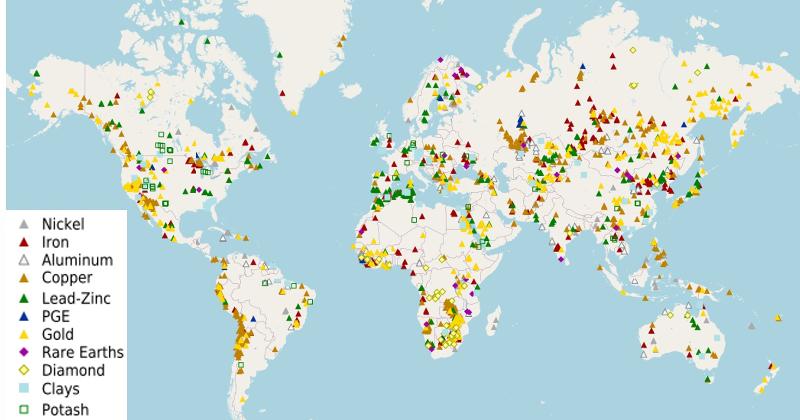
People and Earth Resources: Ore Formation and Distribution, Economics and Intangibles--with Discussion Prompts
Earth Science Extras
by Russ Colson

Distribution of major ore mineral deposits of the world, from the United States Geological Survey mineral data base: https://mrdata.usgs.gov/general/map-global.html) (taken 2022).
Understanding of People and Natural Resources shows up in both the middle school and high school earth science standards in Minnesota. For example,understanding of the processes that cause uneven distribution of resources and consideration of the implications of that uneven distribution (both of which are discussed briefly in this lesson), is one of the Minnesota earth science benchmarks for 6th grade students. Consider the standard, reproduced below.
6E.3.2.1.2 Construct a scientific explanation based on evidence for how the uneven distribution of Earth's mineral, energy, or groundwater resources is the result of past geological processes. (P: 6, CC: 2, CI: ESS3) Emphasis is on how these resources are limited and typically non-renewable on a human timeframe. Examples of uneven distribution of resources may include petroleum (like in the North Dakota Bakken Shale), metal ores (like iron in the rocks of Minnesota's Iron Range), or groundwater in the different regions of Minnesota.
The entire periodic table of elements can be found virtually anywhere on Earth, but only in select locations have particular elements become sufficiently concentrated to make an ore. An ore is defined economically, rather than geochemically, in that an ore is a material that can be mined at a profit. However, the naturally-enhanced concentration of an element is one factor in making it profitable to mine (other factors will be examined later in this lesson).
One way that elements become concentrated is by chemical partitioning processes in which elements are distributed, or 'partitioned,' between different phases in various natural settings. For example, depending on conditions of temperature, pressure, oxygen, acidity, and other characteristics of a fluid, Tin (Sn) or Gold (Au) might partition into the fluid phase that is moving through pore spaces and fractures in rock, or into a solid phase that crystallizes out in a particular location in the rock. Concentration occurs when, for example, a fluid dissolves a particular element from a large mass of rock, transports that element through pore space and fractures in the rock, and then precipitates the element into a much smaller volume (thus concentrating it).
Concentrating processes can involve water in a variety of ways, including hydrothermal water (hot water percolating through a rock, usually at depth in the crust), ground water (such as rain water leaching down through a column of soil, sediment, and rock), or ocean water. For example, rain water with lots of oxygen in it can dissolve Copper (Cu) and carry that copper downward to the water table, where reducing (lower oxygen) conditions might cause the copper to precipitate out. Althernatively, in some tropical environments, high rainfall can dissolve and leach away most elements, leaving behind the insoluble Aluminum (Al) minerals, thus concentration Al by leaving it behind.
Other concentratng processes can involve crystallization from a magma in which the elements partition between the crystallizing phases and the remaining magma, resulting in concentration of elements in its 'preferred' phase. A truly concentrating event requires that the magma and crystalline phases become separate somehow. The minerals and magma can become separated by gravity separation if there is a density difference, or by weight of overlying rock pressing the liquid out of a crystal mush (as just two examples). Incompatible elements, that is, elements that tend to stay with the melt rather than partition into the crystalline phases, tend to be concentrated in magmas that are more 'evolved,' that is, have had more crystallization of solids from them. This includes silicate-rich igneous rocks like granite. Au, being mostly incompatible, is more likely to be concentrated in the 'evolved' granite than in a 'primitive' basalt.
Sometimes ore minerals can be transported and concentrated by sedimentary processes. For example, gold and diamonds are both resistant to weathering and can weather out of an igneous rock in which they originally formed and become concentrated somewhere downstream where they preferentially settle out. This type of ore formation still requires proximiity to the kind of igneous or hydrothermal process that first concentrates the material, but the sedimentary process can move the material downstream and potentially concentrate it further.
The summary is this: To produce an ore, some combination of chemical and physical processes must concentrate an element. This usually requires special conditions, such as tectonic activity (like occurs at plate boundaries on Earth), special climatic conditions, special oxidation conditions (such as the low oxygen conditions of a bog or the low oxygen conditions of the ancient Precambrian atmosphere before phtosynthetic life was abundant), special acidity conditions (such as the reduced acidity that might occur in a fluid when it encounters and reacts with limestone), and so one. For example, at some plate tectonic boundaries, heat (from volcanic, plutonic, or metamorphic activity) provides energy both to heat hydrothermal water and to drive that water in convective cycles through rock so that elements can be moved from one place to another. The process in its most basic form is this: to get an ore, we 1) take an element from a large mass of material (for example, dissolving it in hydrothermal water, requring that conditions of temperature, oxygen, acidity, etc favor partitioning of the element into the fluid phase), 2) transport the element to a new location (requiring that the solubility or concentration of the element in the transporting phase be high enough, or periods of time involved long enough, to move a lot of the element, and then 3) precipitate or deposit the element in a relatively smaller volume (requiring that the conditions change so that the element chemically precipitates or mechanically settles out).
This process is shown conceptually below:
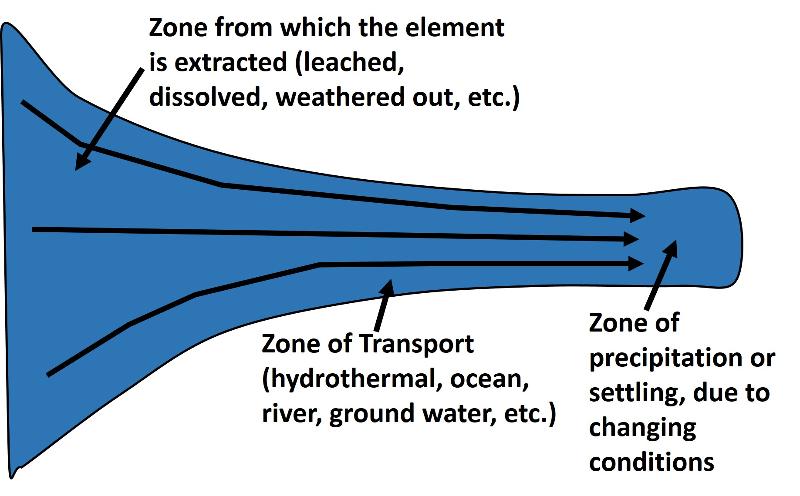
The illustration below comes from the book Learning to Read the Earth and Sky, by Russ and Mary Colson, National Science Teacher Association Press, 2016. The Illustration shows two processes for concentrating gold, one process being magmatic and the other being hydrothermal. Partitioning is shown by a simple ratio, D, which is the concentration of the element in one phase divided by the concentration in another. Study the diagram to figure out how it illustrates the processes described above.
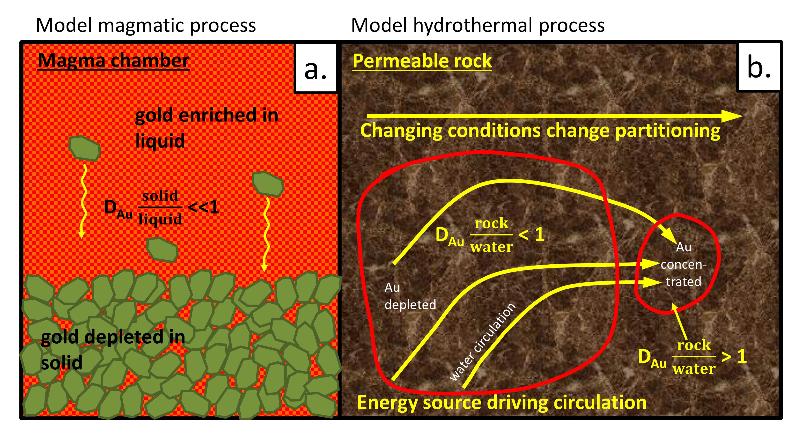
The illustration below shows a sedimentary process for concentrating gold. In this process, nuggets of gold in existing rock in one region (mountains in the illustration, perhaps concentrated by one of the processes above) is weathered from the rock and tumbles down a river until it reaches a place where conditions change (in this case, velocity of the river changes) and the gold particles settle out. This type of deposit is called a placer deposit. Again, study the diagram to figure out what it means.

The complexity and special conditions required for the concentration of elements means that ore deposits do not occur everywhere, and, for some elements, areas of concentration can be quite rare. Consequently, natural resources affect how people in different parts of the world interact with each other because some areas have more of particular resources, while other areas may have none of that resource. This can be both a motivation to cooperation (driven by the need to trade in order to get various resources most efficiently) or to war (driven by the desire to simply take the resources of another people, or the failure to find an agreed practice of trade). Resources that are unevenly distributed include not only elemental resources (what we usually think of when we talk about 'ores') but also energy resources like uranium, coal, oil, or gas. Even renewable energy resources, like wind, hydrothermal, hydroelectric, solar, or tidal, are unevenly distributed on Earth.
For example, consider the map below showing the distribution of potential wind energy in the USA from the McHarg Center project 2100 an Atlas for the Green New Deal, https://mcharg.upenn.edu/2100-project-atlas-green-new-deal
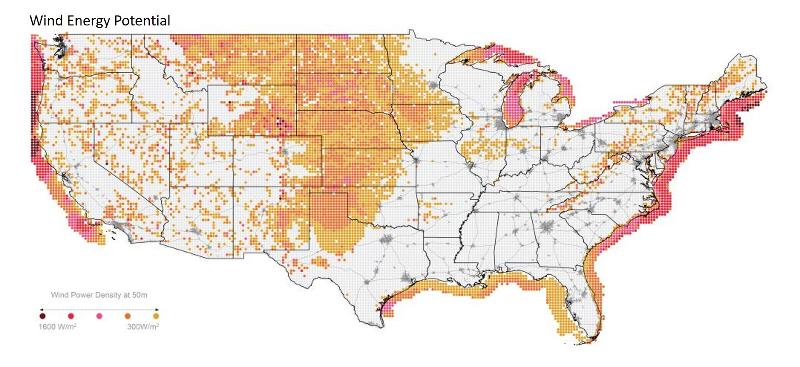
Think about the distribution of wind energy compared to where electrical energy is most in demand. Do they match? Also, think about the implications of wind energy potential over water. Will this be easier or harder (or more expensive or cheaper) to capitalize on? What are the implications of this?
Below is a map of the distribution of known major REE resources around the world. A number of different elemental mineral resources are shown, with the Rare Earth Elements (REE) highlighted (in purple) (from the United State Geological Survey mineral data base: https://mrdata.usgs.gov/general/map-global.html).
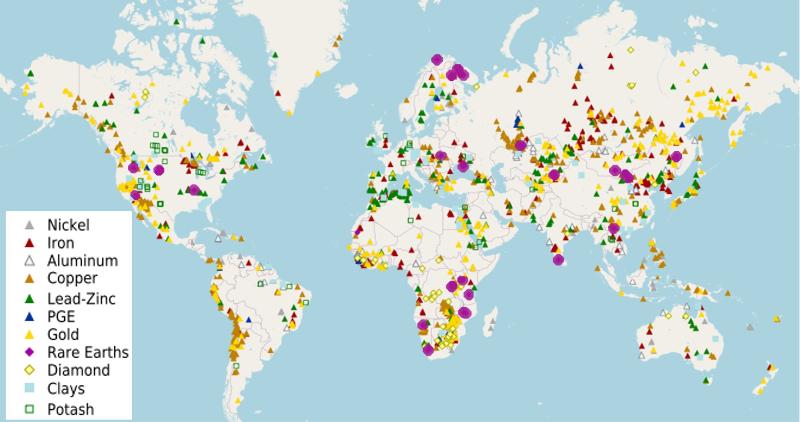
Although there are a number of REE resources around the world, they occur in limited areas and in a limited number of countries, which can require countries without those resources to trade, negotiate, or go to war to get them. REE are becoming an increasingly-critical high-tech resource, used, for example, in the light emitting diodes in smart phone screens and in the manufacture of high-power magnets. Even though there are a number of REE resource locations seen in the map, as of this writing, cheaper labor in China, and other price factors, has resulted in the dominance of China in the mining of REE, which creates political and economic risks for other countries that are critically dependent on those resources. Do you think this should affect government policy? Should, for example, governments either subsidize the production of more local REE or limit imports through tariffs to encourage more local production? This would increase costs of course--is the decrease in national risk worth the increased cost? Why do you think that?
Here is one more illustration of the uneven distribution of resources, in this case the uneven mining of bauxite, the primary ore of aluminum. The source of this map is the British Geological Survey http://www.bgs.ac.uk/mineralsuk/commodity/world/home.html, by way of Wikipedia. Notice that, although some bauxite deposits are found in the USA, none of these are currently a major producer of Aluminum. This means that the USA must import its bauxite for use in Al refineries and manufacture of all Al-bearing products.
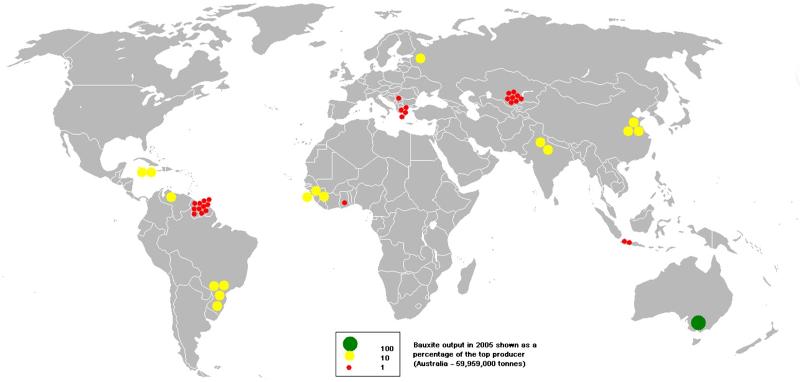
As discussed above in the section on ore forming processes, natural resources are not evenly or equitably distributed. This uneven distribution has had a tremendous influence on the develop of relationships between different people, leading to both cooperation and war.
Spend some time searching online to find one or two specific examples of international interactions driven by resource distribution, thinking about political, economic, and social implications of some particular resource distribution. Examples might include 1) American interaction with South Africa, a major source of many militarily-critical ore minerals, was especially fraught during the apartheid years since the USA needed those resources but disapproved of aphartheid, 2) American interaction with the former Soviet Union whose leader once said that they would conquer the west (through control of natural resources) without firing a shot, was made more complex by the fact that the USSR contolled nearly a sixth of the world's land mass and thus a large percentage of world resources, and of course 3) American interaction with the Mideast oil-producing nations over the past 50 years--the Mideast being a source of multiple conflicts but a critical oil-producing partner. You should be able to find examples where resources have resulted in war or war-like tensions, but also examples of political support or cooperation when other factors (like apartheid in South Africa or governmental style in the Mideast) might have led to less cooperation.
As is clear from the discussion above on the processes for concentrating elements in various geological settings that no one process will produce all ore deposits and therefore ores, although unevenly distributed, will usually not be completely correlated with a single geological process or setting. For example, copper can be deposited in sedimentary layers due to hydrothermal fluid encountering changed conditions (stratabound copper deposits), it can be concentrated by leaching of groundwater down toward the water table (supergene enriched deposits), it can be concentrated by large-scale hydrothermal circulation such as at an oceanic divergent boundary (massive sulfide deposits), it can be concentrated on the sea floor in nodular deposits (a resource that many nations and companies are striving to find a way to capitalize on as of this writing), it can be concentrated around plutonic features that provide heat and shattered rock that facilitate fluid circulation that concentrates Cu (porphyry copper deposts), and so on.
However, often there are particular types of deposits that are either economically more favorable, more abundant, or easier to find and access and so become the dominant source for that resource at least for some period of time. The exercise below engages you in thinking about the geological setting for a few selected resources, including iron (used in making steel), copper (used in making electrical wire, brass, and coins), gold (used for jewelry and dentistry), and potash (K-bearing minerals used for fertilizers). By comparing the distribution of known significant resources of these minerals (along with the locations of the top 10 producing locations) to the distribution of different types of geological terranes, you can infer something about the type of geological setting this resource is typically mined from as of 2020-ish (as time passes, and old mines are used up, less favorable mines will of course be developed which may change the appearance of these maps).
Note: Below is the key to the types of mountain building events and rifting in the following maps.
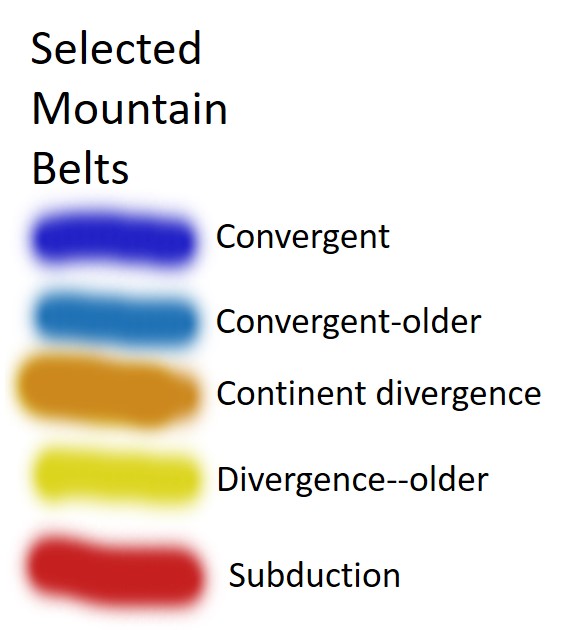
The Minnesota State High School Earth Science Standards (Benchmarks) include the following statement of the expectations of high school students in Minnesota. High school students should be able to:
9E.4.1.1.3 Evaluate competing design solutions for developing, managing, and utilizing energy and mineral resources based on cost-benefit ratios.* (P: 7, CC: 5, CI: ESS3, ETS1) Emphasis is on the conservation, recycling, and reuse of resources (such as minerals, metals or soils) where possible, and on minimizing impacts where it is not...
This, on the face of it, is a mind-bogglingly complex activity to expect high school students to do. It involves not only an understanding of science (geology and chemistry of ore prospecting, mining, and refining) but economic thinking as well (cost of all the steps involved in bringing an ore deposit into production). The first sentence invokes cost-benefit ratios, implying that learning exercises should include numerical simulation, but the second sentence emphasizes the importance of conservation, recycling, and reuse whose primary objective is to preserve the natural environments who value is based on qualitative judgements that are intrinsically non-numerical. Where does one begin with such a teaching standard?
The Minnesota State science standards are based on the high school standards published in the national Next Generation Science Standards (2013). The following text is taken from Chapter 7 of the book Learning to Read the Earth and Sky, by Russ and Mary Colson, NSTA Press, 2016, MODELING, PART 2: MATHEMATICAL MODELING . It specifically considers the NGSS standard that the state standard is based on, addressing the seemingly mind-boggling nature of this standard. In this text, "PE" stands for "performance expectation" and is the standard that students are expected to achieve.
There are a couple of NGSS PEs addressing computational simulations and representations that are so broad in scope that we feel we should offer our interpretation of their educational goal and how that goal can be reached. These PEs deal with relationships among interacting systems at the highest level and thus fall into the category of "model of models"...
HS-ESS3-3. Create a computational simulation to illustrate the relationships among management of natural resources, the sustainability of human populations, and biodiversity. [Clarification statement: Examples of factors that affect the management of natural resources include costs of resource extraction and waste management, per-capita consumption, and the development of new technologies. Examples of factors that affect human sustainability include agricultural efficiency, levels of conservation, and urban planning.]
The mind-boggling implications of these standards becomes apparent when you consider that the factors involved are not additive but are interactive, and that each interacting factor is in itself dependent on a complex interplay of subfactors, identification of which requires input from disciplines outside earth science. For example, the clarification statement of HS-ESS3-3 includes seven interacting factors, and the subfactors that affect just one of these factors—for example, cost of extracting a resource—are also many and complex.
The mind boggles.
The book, Learning to Read the Earth and Sky, nevertheless suggests that numerical algorithmic analysis of ore-related economic problems can be addressed by high school students if the problems are broken down into parts. For example, one part of understanding mining is the cost of the mining and refining process itself. Students can identify the cost steps involved in mining and processing an ore and make semi-quantitative evaluations of how costs of particular steps will vary depending on depth of ore, distance to refinery, and so on.
Notice the semi-quantitative cost relationships in the chart. Take note that these are not intended to be 'real world' costs, values which would be outside the reach of a classroom, but rather to be mathematically-conceptual costs that show how costs will vary, in concept. Learning to Read the Earth and Sky explains the cost of removing layers of overburden as follows:
Students can reason that removing the top layer will have some fixed cost, let's say C0 (for cost of the 0th layer). The next layer down (the first layer below the top, 0th, layer) will require bringing the same mass of material up from greater depth, and so the cost will be C0 plus some percentage of C0, say 10% (cost = C0 × 1.1). The second layer down will have an incrementally greater cost than layers 0 and 1—mathematically, its cost might be represented by C0 × 1.1 × 1.1. In this way, students can realize that the cost will increase <in a non-linear fashion> with increasing depth of overburden (cost = C0 × 1.1d, where d = layer number).
The Minnesota state standard cited above implies that the emphasis is on recyling, etc. But of course, to evaluate whether recycling is economically cheaper than mining, we need to understand the cost of mining, as was done above AND the cost of recycling. Can you come up with a similar process for evaluating the cost of recycling? What would it include? Do you include the 'volunteer time' cost of individuals choosing to recycle their own material? What is the cost of separating recyclable materials from other materials in a waste stream? How efficient is that process? What refining of the waste still must be done to return the resource to a usable form?
When I was in grade school, a huge frog lived in a hole on the edge of the playground at the Kansas school I attended. The frog got used to us, and we got used to the frog, and often when we went out to play at recess, the frog would hop from its hole and play. Many of us came to like the frog and look forward to seeing it when we weren't in class. We all talked about the frog, and why he lived in that hole in the ground, and the frog brought a great deal of joy. The frog was valuable to us.
Perhaps not valuable to all of us. One day, a kid from the class behind mine grabbed a baseball bat and sat at the hole waiting for the frog. When the frog emerged, he smashed it with the bat. He valued attention much more than he valued the frog.
I'm wondering, when you hear this true story, how you react to it. Do you chaff at the lost joy that the frog once brought us, realizing that the frog had value and the kid had no right to smash it? Or do you think that the frog's life was its own, and had value in itself, not just because it brought us joy, and its life was not something to take on a whim? Or do you simply think, it was just a frog, what's the big deal?
The different reactions parallel how different people value natural resources that are not owned by anyone in particular, but must be held in common; things like the air, the water, the land, the sunrise. Things like the flora and fauna of the world. For some, it's just a frog, what's the big deal? For others its something that brings us joy, or something that has value in its own right. It is difficult or impossible to put a monetary value on such intangible things, and equally difficult to know who pays that monetary value when an individual or company, in pursuing profit of some sort, undoes part of that value.
In the end, we put a type of value on it, collectively as a society, when we choose laws to protect things of the world that are held in common, laws like the clean air act, or the clean water act, or any of the laws that protect the land itself like RCRA or CERCLA. These laws have a monetary cost that presumably we, collectively, are willing to pay in order to protect the intangible value in the natural world we live in.
We, as a society, have already made many of our decisions about the air, water, and land, although those decisions are continually revisited. But as of this writing, we as a world community are on the threshold of making decisions about one of the last untouched frontiers of our world--that is, the deep ocean. As our world longs for more Ni and Cu to make batteries for our new electric cars, we look to the untouched resources of the ocean bottom where manganese and phosphate nodules await our negotiation of what nation owns those materials and who can mine them.
The thing is, the deep ocean, being an extremely stable environment, is one of the most diverse places on Earth...and one of the most vulnerable. How do we weigh the value of what will be lost if we mine it? How do we weigh the value to human wellbeing, and even environmental benefits, of extracting and using those resources?
Spend some time searching online for information, ideas, and concerns about mining the sea floor. What resources can be mined there? What are the potential consequences? What are the problems in finding a way to mine it?
You might search on three different ideas:
Take notes and think of comments and questions you could offer in a discussion. Try to understand, not simply take sides.
last updated 11/7/2022. Text and pictures are the property of Russ Colson, except as noted.